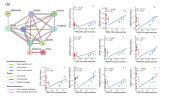hotblack
Senior Member (Voting Rights)
Genecards links for easy perusal, sorry I lost the nice colour coding and not all have directly associated genes, I haven’t checked them all individually yet, just generated the URLs
Baseline
Lower:
ANXA3
VIM
RAP1A
PRKAR2A
SCRN1
PCSK6
PPP1R14A
SYNCRIP
DARS1
MPST
DAPP1
PAFAH1B1
PGD
TXNDC5
FKBP3
ADH5
HNRNPK
RDX
KPNB1
CMPK1
RAB7A
AKR1A1
CNPY2
PTGES3
PSMA5
Higher:
BLMH
TBCA
GGCT
NSF
CD84
ACTN3
15 mins after exercise
Lower:
DSG1
RAP1A
SERPIN89
PRKAR2A
SCP2
GAB
DARS1
TXNDC5
PTPN11
ADH5
PDCD6IP
CRLF3
HNRNPK
TAOK3
GSTP1
PGK1
ERP44
P1L4 (no genecard, see RPL4, thanks @Hutan)
IPO07 (no genecard, possibly IPO7 ?)
VBP1
FKBP3
UBE2L3
PSMA4
USO1
INPP4B
P4HB
YWHAE
CLTA
HYOU1
TPM3
PDIA4
RDX
RAB8B
PTGES3
CALR
Higher:
BLMH
PRDX6
ADD1
TFRC
24 hours after exercise
Lower:
VIM
SYNCRIP
PRKAR2A
ANXA3
ARCN1
DARS1
VBP1
TPT1
Higher:
GGCT
Lower:
ANXA3
VIM
RAP1A
PRKAR2A
SCRN1
PCSK6
PPP1R14A
SYNCRIP
DARS1
MPST
DAPP1
PAFAH1B1
PGD
TXNDC5
FKBP3
ADH5
HNRNPK
RDX
KPNB1
CMPK1
RAB7A
AKR1A1
CNPY2
PTGES3
PSMA5
Higher:
BLMH
TBCA
GGCT
NSF
CD84
ACTN3
15 mins after exercise
Lower:
DSG1
RAP1A
SERPIN89
PRKAR2A
SCP2
GAB
DARS1
TXNDC5
PTPN11
ADH5
PDCD6IP
CRLF3
HNRNPK
TAOK3
GSTP1
PGK1
ERP44
P1L4 (no genecard, see RPL4, thanks @Hutan)
IPO07 (no genecard, possibly IPO7 ?)
VBP1
FKBP3
UBE2L3
PSMA4
USO1
INPP4B
P4HB
YWHAE
CLTA
HYOU1
TPM3
PDIA4
RDX
RAB8B
PTGES3
CALR
Higher:
BLMH
PRDX6
ADD1
TFRC
24 hours after exercise
Lower:
VIM
SYNCRIP
PRKAR2A
ANXA3
ARCN1
DARS1
VBP1
TPT1
Higher:
GGCT
Last edited:







